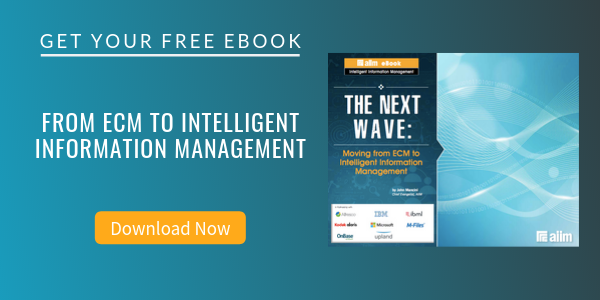
5 Reasons We Need a New Approach to Content Management
Enterprise Content Management (ECM)
How did we get here, and where do we go now?
In the late 1990s, Enterprise Content Management became a mainstream technology (at least for large organizations) by first focusing on early adopters eager to automate high-value, mission-critical, and document-intensive processes critical to gaining competitive advantage. Organizations (and the suppliers who supported them) next applied ECM platforms to solving core back-office automation challenges – like accounts payable, invoice processing, contracts management, and HR administration. Over time, we began to think that ultimately, there would be a convergence in an organization around a single ECM platform.
The reality turned out to be something very different. There are information management disrupters all around us! Here are a few:
- Organizations are realize that the single repository dream – if it ever was a dream – is over.
- SaaS and low-code process solutions are creating the potential of a new generation of silos on steroids.
- When it comes to legacy ECM, organizations can’t just throw the baby out with the bathwater.
- New and modern cloud-based solutions can’t just be slapped on to what you have now.
- Saving everything still isn’t the right answer.
Organizations need to look strategically at these kinds of information federation questions:
- How can you access valuable content in a legacy system and still sunset the application itself?
- Is it possible to create a common interface for all content regardless of new or legacy?
- Is it possible to have virtual access to archived content in multiple repositories and real-time conversion of only the data that is needed?
- Is it possible to reduce storage management costs across multiple platforms and repositories – and still preserve access to these archives when needed?
- How can you access content from multiple repositories within an application and not create multiple versions of the same content?
- How can you begin to understand – and manage – all of the “dark data” that is hidden away in long-neglected or abandoned applications and repositories?
You might be interested in a new Tip Sheet I've put together - 5 Reasons We Need a New Approach to Content Management.
About John Mancini
John Mancini is the President of Content Results, LLC and the Past President of AIIM. He is a well-known author, speaker, and advisor on information management, digital transformation and intelligent automation. John is a frequent keynote speaker and author of more than 30 eBooks on a variety of topics. He can be found on Twitter, LinkedIn and Facebook as jmancini77. Recent keynote topics include: The Stairway to Digital Transformation Navigating Disruptive Waters — 4 Things You Need to Know to Build Your Digital Transformation Strategy Getting Ahead of the Digital Transformation Curve Viewing Information Management Through a New Lens Digital Disruption: 6 Strategies to Avoid Being “Blockbustered” Specialties: Keynote speaker and writer on AI, RPA, intelligent Information Management, Intelligent Automation and Digital Transformation. Consensus-building with Boards to create strategic focus, action, and accountability. Extensive public speaking and public relations work Conversant and experienced in major technology issues and trends. Expert on inbound and content marketing, particularly in an association environment and on the Hubspot platform. John is a Phi Beta Kappa graduate of the College of William and Mary, and holds an M.A. in Public Policy from the Woodrow Wilson School at Princeton University.



